Jackson M.J. Micro and Nanomanufacturing
Подождите немного. Документ загружается.

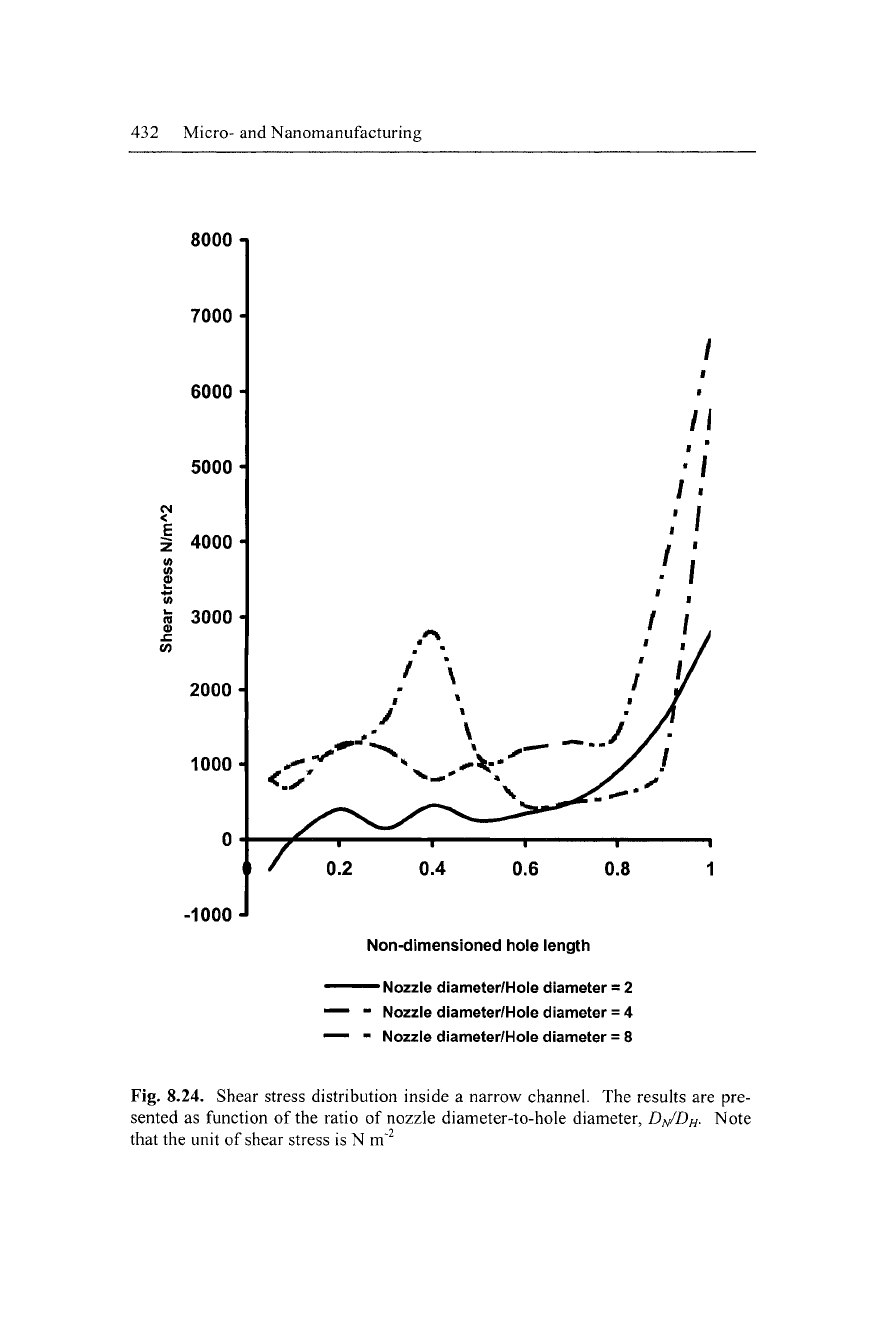
432 Micro- and Nanomanufacturing
8000 1
7000 H
6000 i
5000 H
^ 4000 H
(0
3000 H
2000 H
1000 H
-1000 J
Non-dimensioned hole length
^^—^ Nozzle diameter/Hole diameter = 2
^" - Nozzle diameter/Hole diameter = 4
^— - Nozzle diameter/Hole diameter = 8
Fig. 8.24. Shear stress distribution inside a narrow channel. The results are pre-
sented as function of the ratio of nozzle diameter-to-hole diameter,
DJ^/DH-
Note
that the unit of shear stress is N m"^
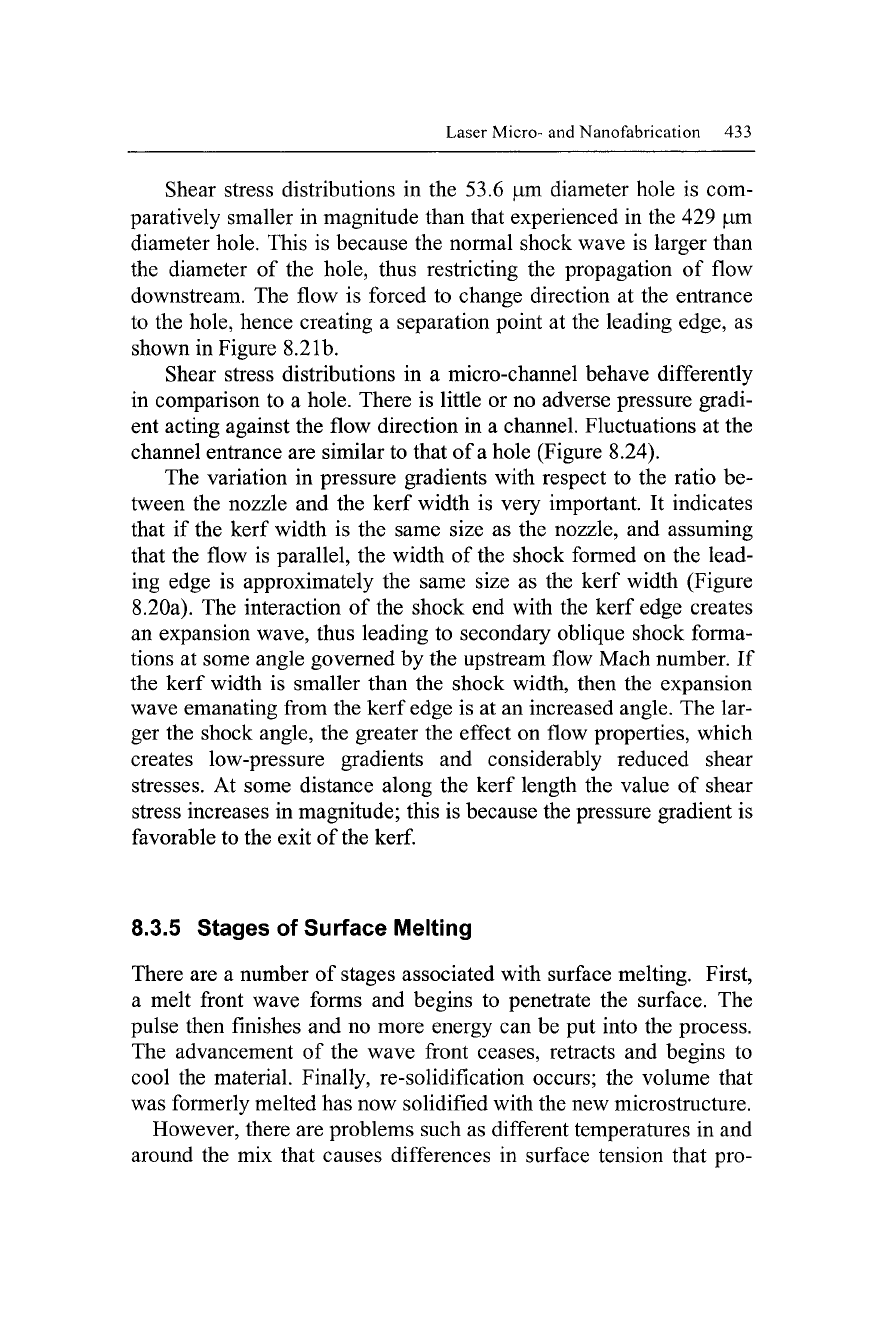
Laser Micro- and Nanofabrication 433
Shear stress distributions in the 53.6 |Lim diameter hole is com-
paratively smaller in magnitude than that experienced in the 429 |Lim
diameter hole. This is because the normal shock wave is larger than
the diameter of the hole, thus restricting the propagation of flow
downstream. The flow is forced to change direction at the entrance
to the hole, hence creating a separation point at the leading edge, as
shown in Figure 8.21b.
Shear stress distributions in a micro-channel behave differently
in comparison to a hole. There is little or no adverse pressure gradi-
ent acting against the flow direction in a channel. Fluctuations at the
channel entrance are similar to that of
a
hole (Figure 8.24).
The variation in pressure gradients with respect to the ratio be-
tween the nozzle and the kerf width is very important. It indicates
that if the kerf width is the same size as the nozzle, and assuming
that the flow is parallel, the width of the shock formed on the lead-
ing edge is approximately the same size as the kerf width (Figure
8.20a). The interaction of the shock end with the kerf edge creates
an expansion wave, thus leading to secondary oblique shock forma-
tions at some angle governed by the upstream flow Mach number. If
the kerf width is smaller than the shock width, then the expansion
wave emanating from the kerf edge is at an increased angle. The lar-
ger the shock angle, the greater the effect on flow properties, which
creates low-pressure gradients and considerably reduced shear
stresses. At some distance along the kerf length the value of shear
stress increases in magnitude; this is because the pressure gradient is
favorable to the exit of
the
kerf.
8.3.5 Stages of Surface Melting
There are a number of stages associated with surface melting. First,
a melt front wave forms and begins to penetrate the surface. The
pulse then finishes and no more energy can be put into the process.
The advancement of the wave front ceases, retracts and begins to
cool the material. Finally, re-solidification occurs; the volume that
was formerly melted has now solidified with the new microstructure.
However, there are problems such as different temperatures in and
around the mix that causes differences in surface tension that pro-
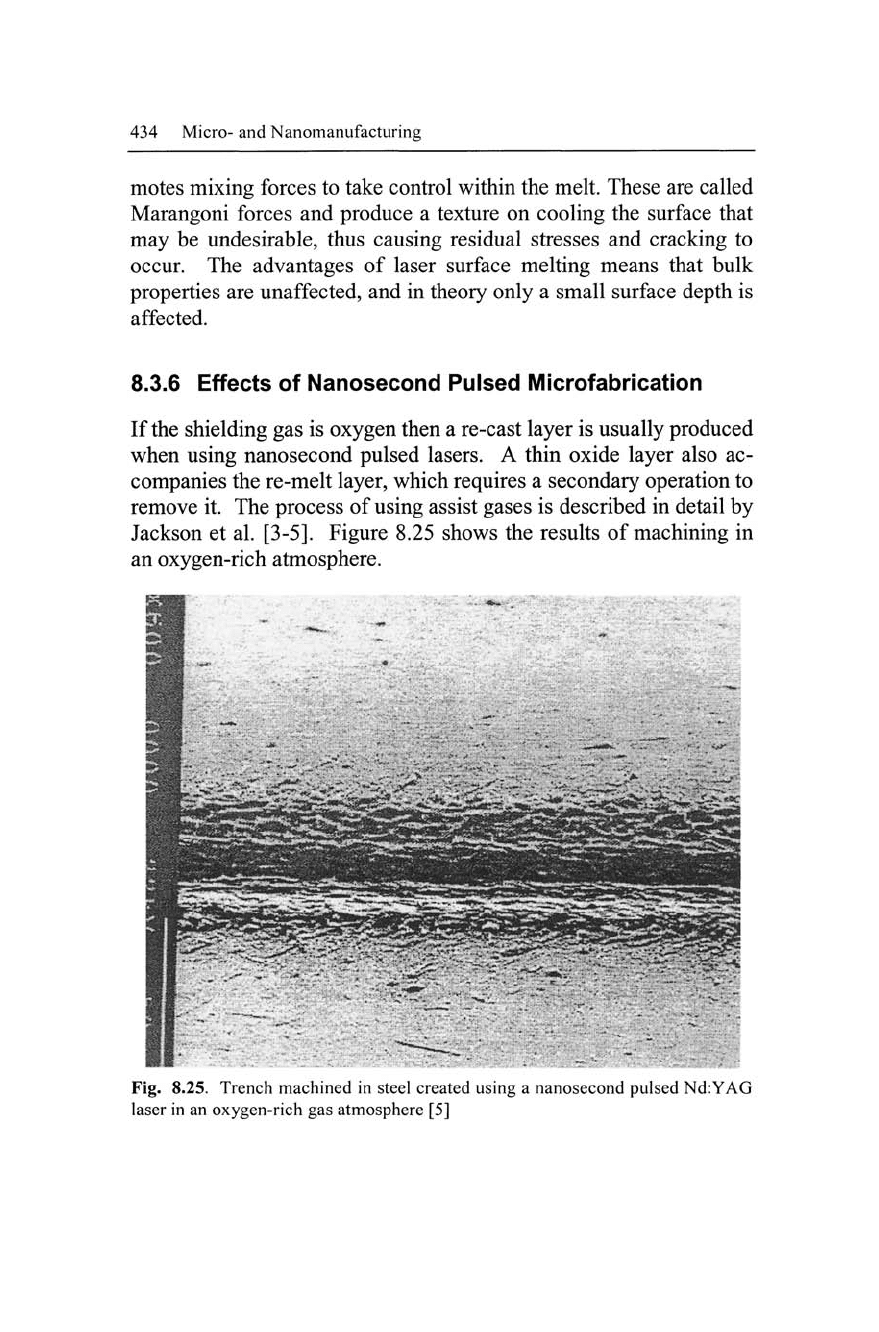
434 Micro- and Nanomanufacturing
motes mixing forces to take control within the melt. These are called
Marangoni forces and produce a texture on cooling the surface that
may be undesirable, thus causing residual stresses and cracking to
occur. The advantages of laser surface melting means that bulk
properties are unaffected, and in theory only a small surface depth is
affected.
8.3.6 Effects of Nanosecond Pulsed Microfabrication
If the shielding gas is oxygen then a re-cast layer is usually produced
when using nanosecond pulsed lasers. A thin oxide layer also ac-
companies the re-melt layer, which requires a secondary operation to
remove it. The process of using assist gases is described in detail by
Jackson et al.
[3-5].
Figure 8.25 shows the results of machining in
an oxygen-rich atmosphere.
Fig. 8.25. Trench machined in steel created using a nanosecond pulsed Nd:YAG
laser in an oxygen-rich gas atmosphere [5]
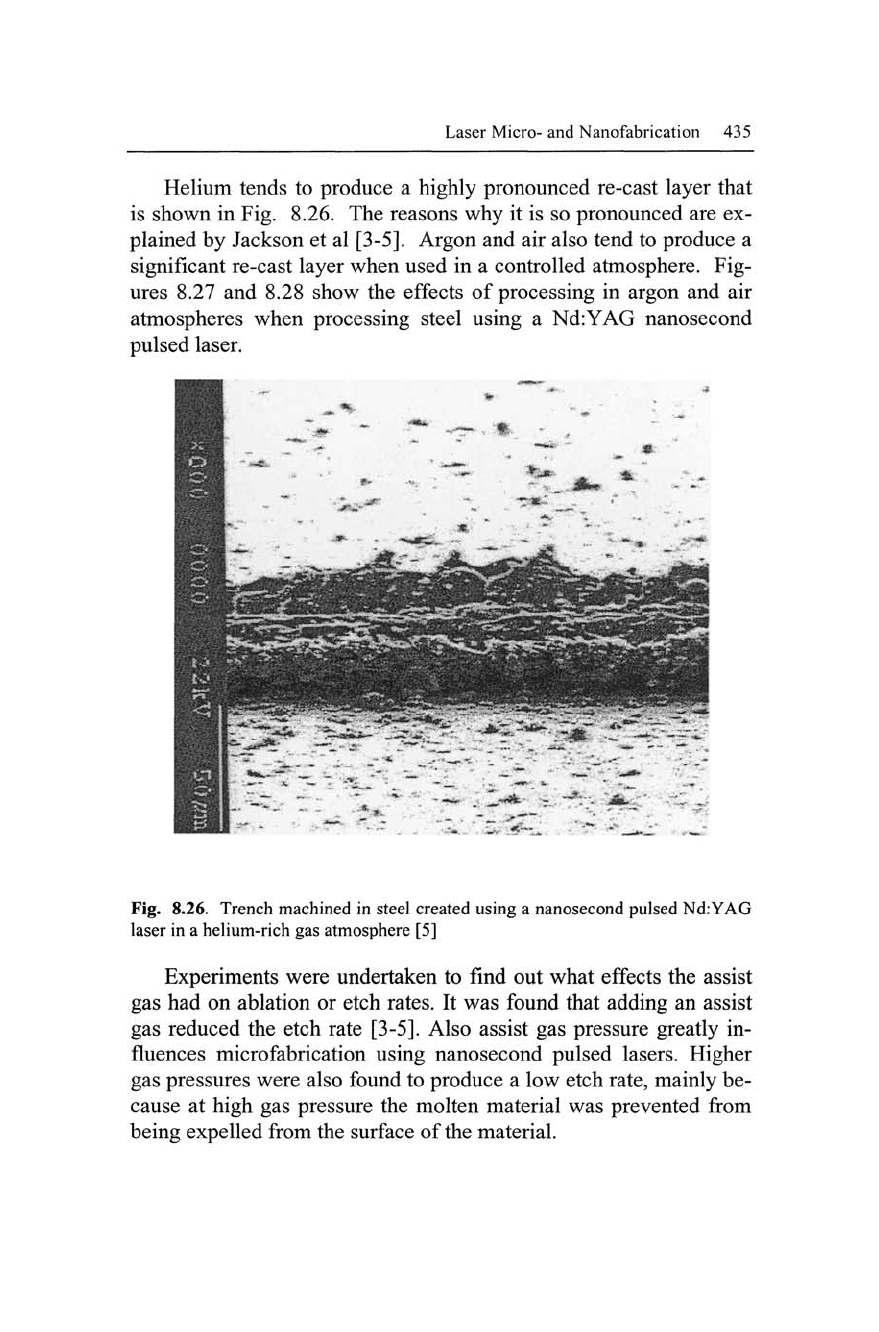
Laser Micro- and Nanofabrication 435
Helium tends to produce a highly pronounced re-cast layer that
is shown in Fig. 8.26. The reasons why it is so pronounced are ex-
plained by Jackson et al
[3-5].
Argon and air also tend to produce a
significant re-cast layer when used in a controlled atmosphere. Fig-
ures 8.27 and 8.28 show the effects of processing in argon and air
atmospheres when processing steel using a Nd:YAG nanosecond
pulsed laser.
Fig. 8.26. Trench machined in steel created using a nanosecond pulsed NdiYAG
laser in a helium-rich gas atmosphere [5]
Experiments were undertaken to find out what effects the assist
gas had on ablation or etch rates. It was found that adding an assist
gas reduced the etch rate
[3-5].
Also assist gas pressure greatly in-
fluences microfabrication using nanosecond pulsed lasers. Higher
gas pressures were also found to produce a low etch rate, mainly be-
cause at high gas pressure the molten material was prevented from
being expelled from the surface of
the
material.
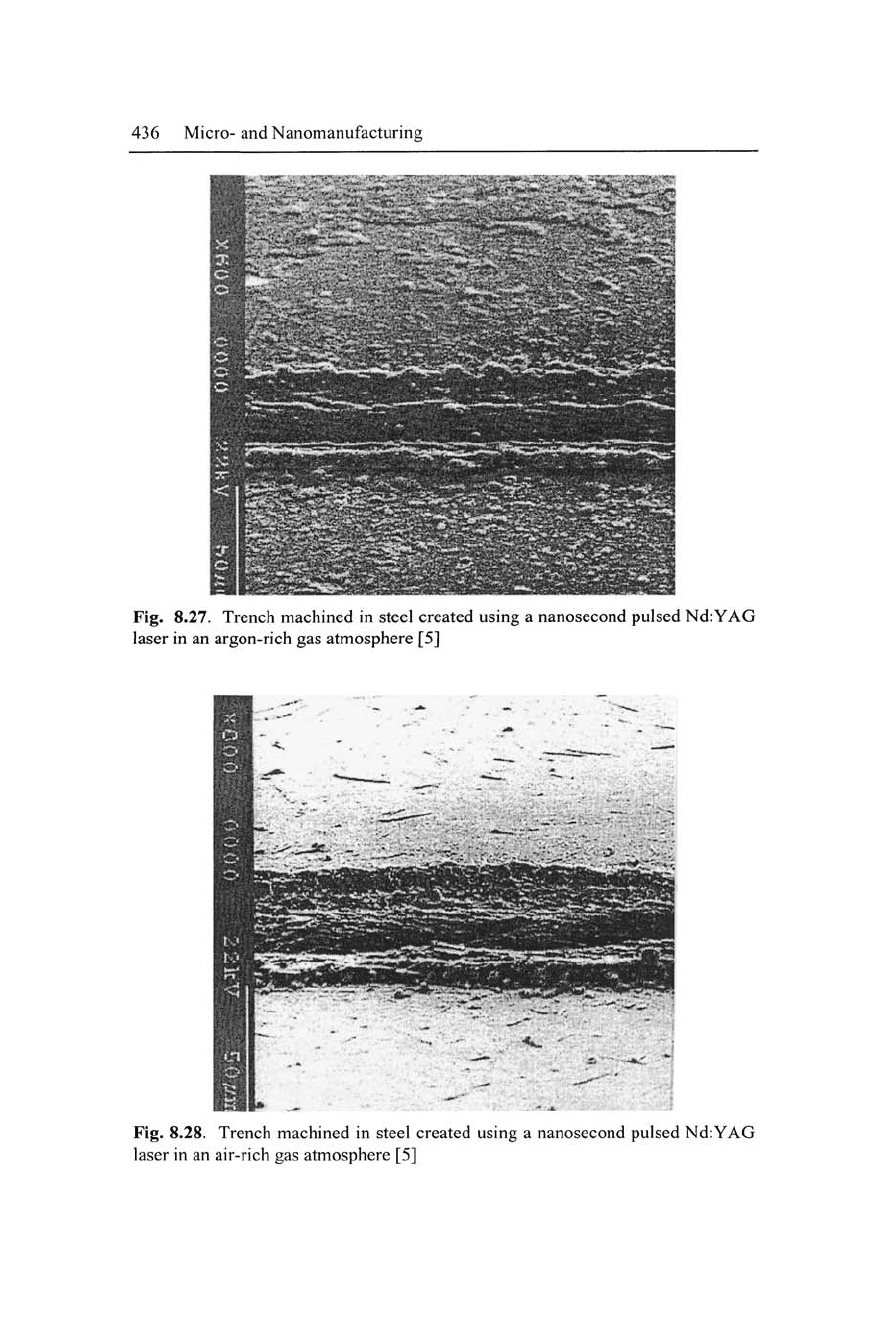
436 Micro- and Nanomanufacturing
Fig. 8.27. Trench machined in steel created using a nanosecond pulsed NdiYAG
laser in an argon-rich gas atmosphere [5]
Fig. 8.28. Trench machined in steel created using a nanosecond pulsed Nd:YAG
laser in an air-rich gas atmosphere [5]
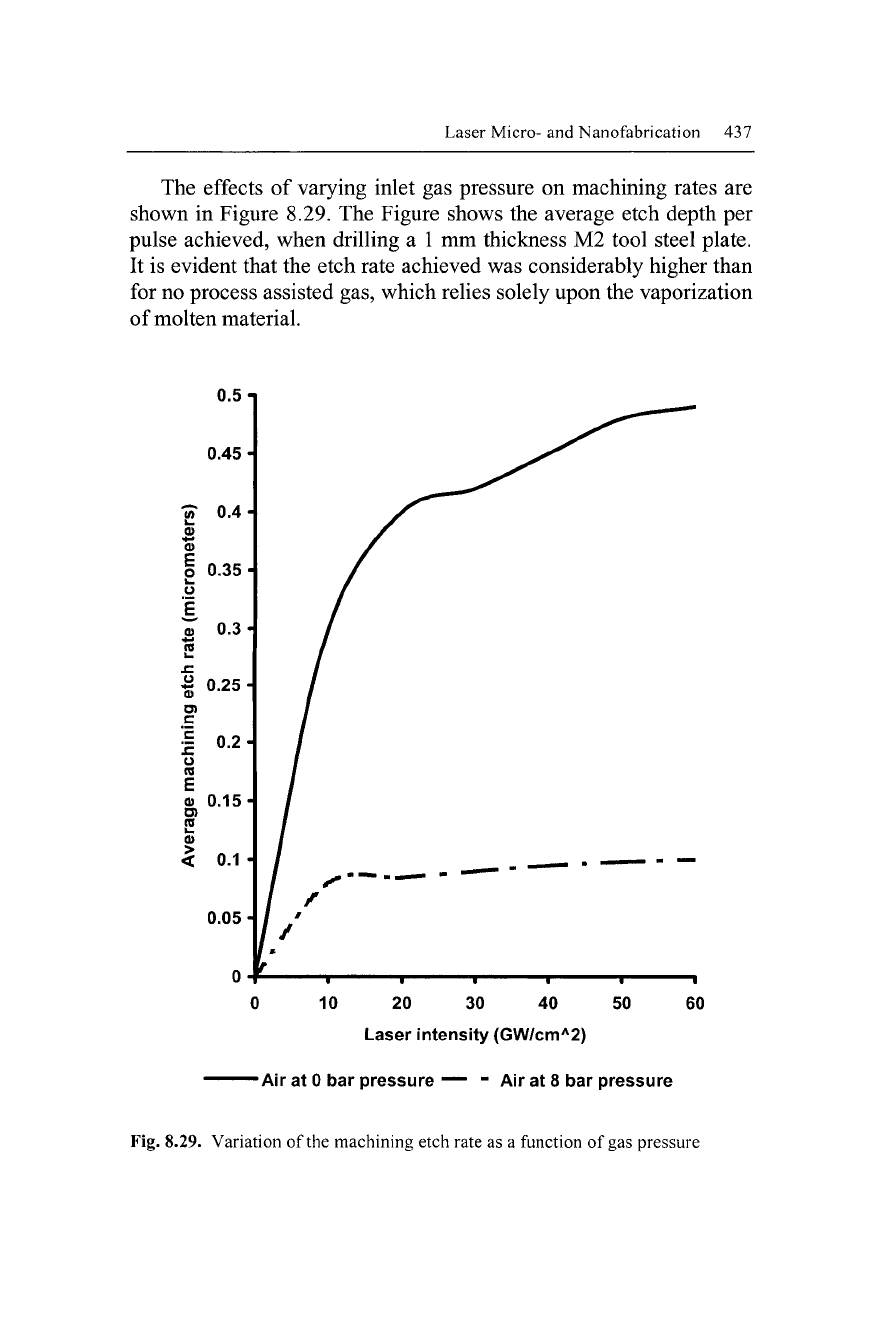
Laser Micro- and Nanofabrication 437
The effects of varying inlet gas pressure on machining rates are
shown in Figure 8.29. The Figure shows the average etch depth per
pulse achieved, when drilling a
1
mm thickness M2 tool steel plate.
It is evident that the etch rate achieved was considerably higher than
for no process assisted gas, which relies solely upon the vaporization
of molten material.
10 20 30 40 50
Laser intensity (GW/cm'^2)
60
•Air at 0 bar pressure — - Air at 8 bar pressure
Fig. 8.29. Variation of the machining etch rate as a function of gas pressure
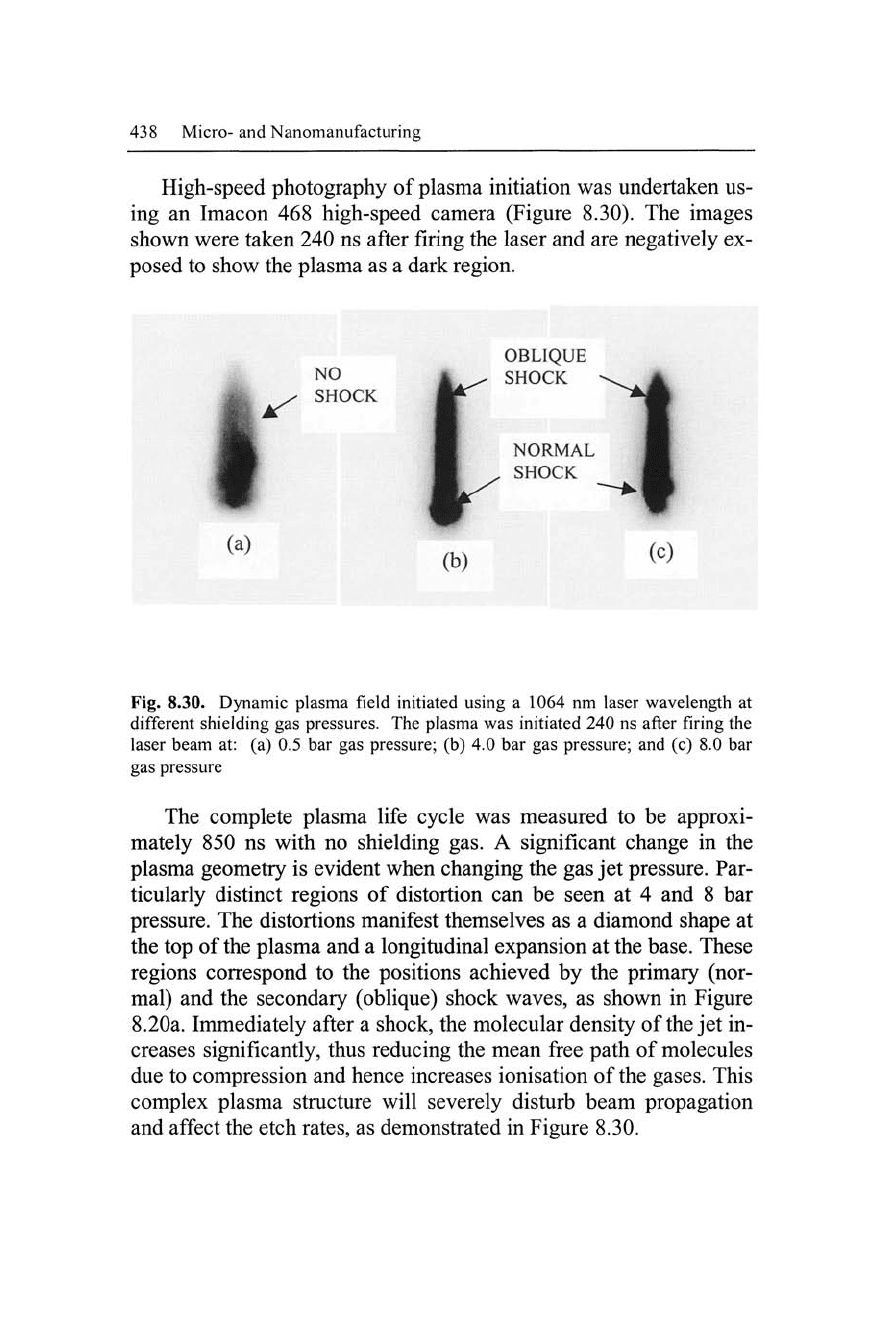
438 Micro-and Nanomanufacturing
High-speed photography of plasma initiation was undertaken us-
ing an Imacon 468 high-speed camera (Figure 8.30). The images
shown were taken 240 ns after firing the laser and are negatively ex-
posed to show the plasma as a dark region.
OBLIQUE
NO 4 ^ SHOCK
SHOCK
NORMAL
SHOCK
^'^ (b) «^)
Fig. 8.30. Dynamic plasma field initiated using a 1064 nm laser wavelength at
different shielding gas pressures. The plasma was initiated 240 ns after firing the
laser beam at: (a) 0.5 bar gas pressure; (b) 4.0 bar gas pressure; and (c) 8.0 bar
gas pressure
The complete plasma life cycle was measured to be approxi-
mately 850 ns with no shielding gas. A significant change in the
plasma geometry is evident when changing the gas jet pressure. Par-
ticularly distinct regions of distortion can be seen at 4 and 8 bar
pressure. The distortions manifest themselves as a diamond shape at
the top of
the
plasma and a longitudinal expansion at the base. These
regions correspond to the positions achieved by the primary (nor-
mal) and the secondary (oblique) shock waves, as shown in Figure
8.20a.
Immediately after a shock, the molecular density of the jet in-
creases significantly, thus reducing the mean free path of molecules
due to compression and hence increases ionisation of the gases. This
complex plasma structure will severely disturb beam propagation
and affect the etch rates, as demonstrated in Figure 8.30.
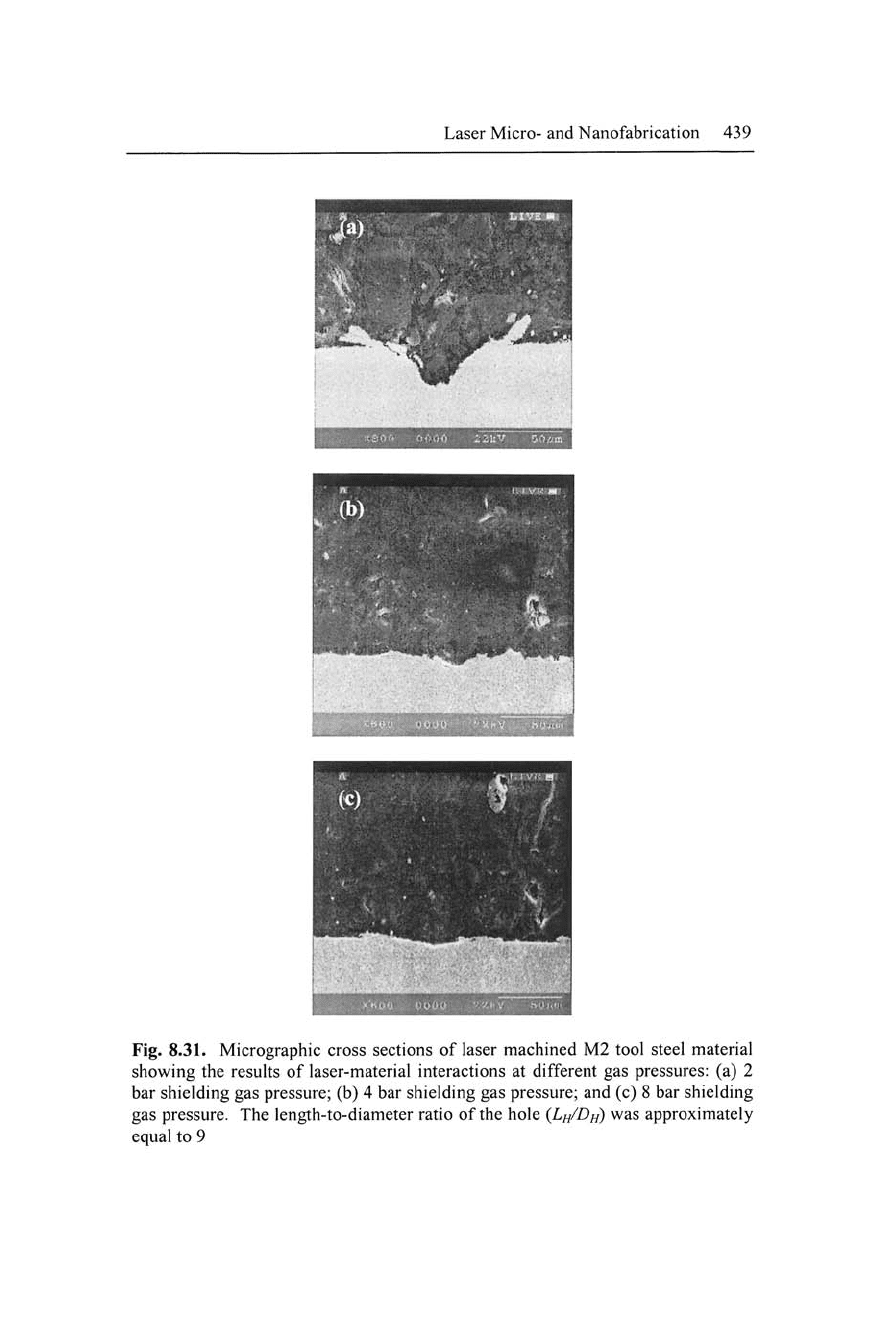
Laser Micro- and Nanofabrication 439
Fig. 8.31. Mi orographic cross sections of laser machined M2 tool steel material
showing the results of laser-material interactions at different gas pressures: (a) 2
bar shielding gas pressure; (b) 4 bar shielding gas pressure; and (c) 8 bar shielding
gas pressure. The length-to-diameter ratio of the hole
(LH/DH)
was approximately
equal to 9
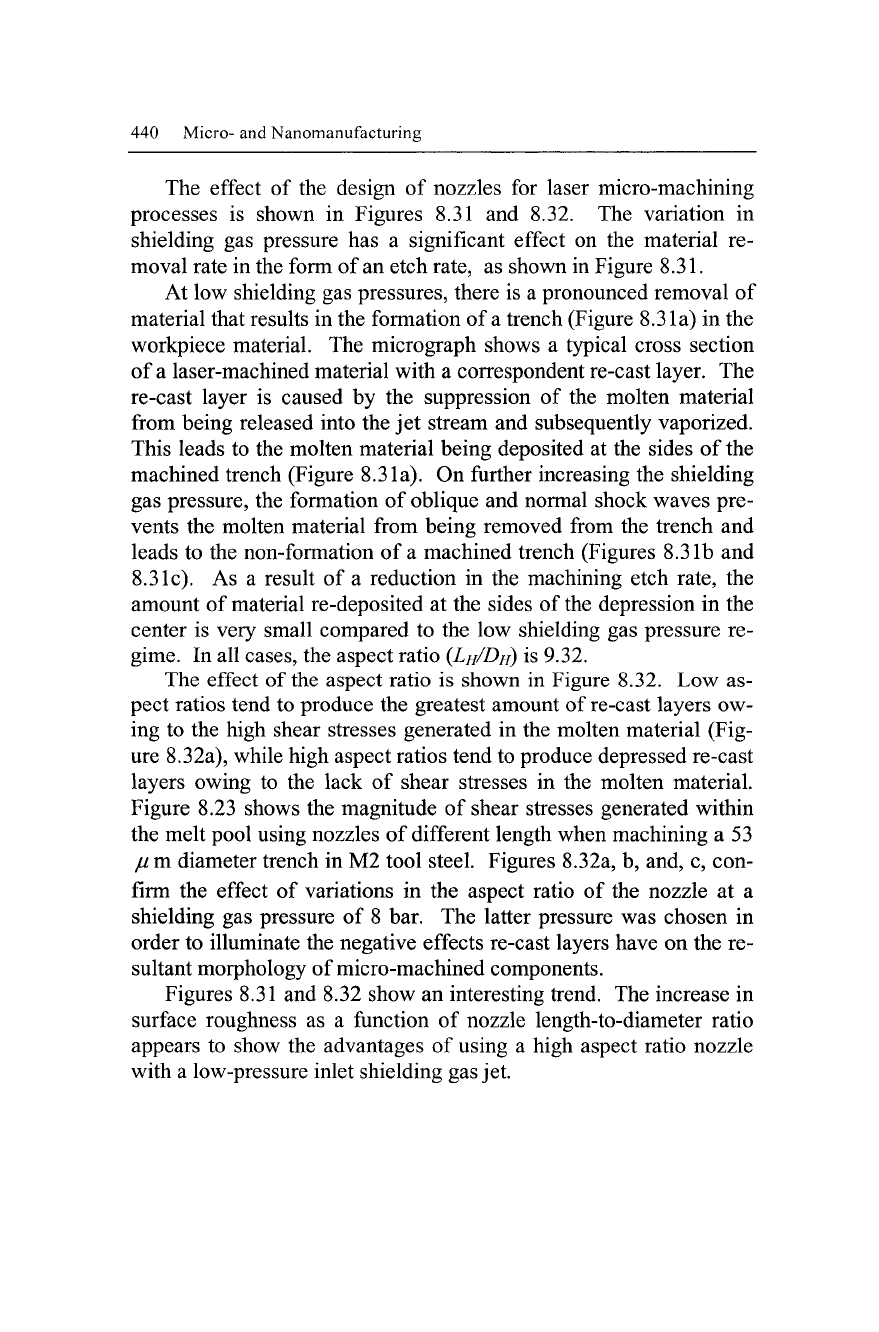
440 Micro- and Nanomanufacturing
The effect of the design of nozzles for laser micro-machining
processes is shown in Figures 8.31 and 8.32. The variation in
shielding gas pressure has a significant effect on the material re-
moval rate in the form of an etch rate, as shown in Figure 8.31.
At low shielding gas pressures, there is a pronounced removal of
material that results in the formation of a trench (Figure 8.3 la) in the
workpiece material. The micrograph shows a typical cross section
of a laser-machined material with a correspondent re-cast layer. The
re-cast layer is caused by the suppression of the molten material
from being released into the jet stream and subsequently vaporized.
This leads to the molten material being deposited at the sides of the
machined trench (Figure 8.31a). On further increasing the shielding
gas pressure, the formation of oblique and normal shock waves pre-
vents the molten material from being removed from the trench and
leads to the non-formation of a machined trench (Figures 8.31b and
8.31c). As a result of a reduction in the machining etch rate, the
amount of material re-deposited at the sides of the depression in the
center is very small compared to the low shielding gas pressure re-
gime. In all cases, the aspect ratio
{LH/DH) is 9.32.
The effect of the aspect ratio is shown in Figure 8.32. Low as-
pect ratios tend to produce the greatest amount of re-cast layers ow-
ing to the high shear stresses generated in the molten material (Fig-
ure 8.32a), while high aspect ratios tend to produce depressed re-cast
layers owing to the lack of shear stresses in the molten material.
Figure 8.23 shows the magnitude of shear stresses generated within
the melt pool using nozzles of different length when machining a 53
// m diameter trench in M2 tool steel. Figures
8.32a,
b, and, c, con-
firm the effect of variations in the aspect ratio of the nozzle at a
shielding gas pressure of 8 bar. The latter pressure was chosen in
order to illuminate the negative effects re-cast layers have on the re-
sultant morphology of micro-machined components.
Figures 8.31 and 8.32 show an interesting trend. The increase in
surface roughness as a function of nozzle length-to-diameter ratio
appears to show the advantages of using a high aspect ratio nozzle
with a low-pressure inlet shielding gas jet.
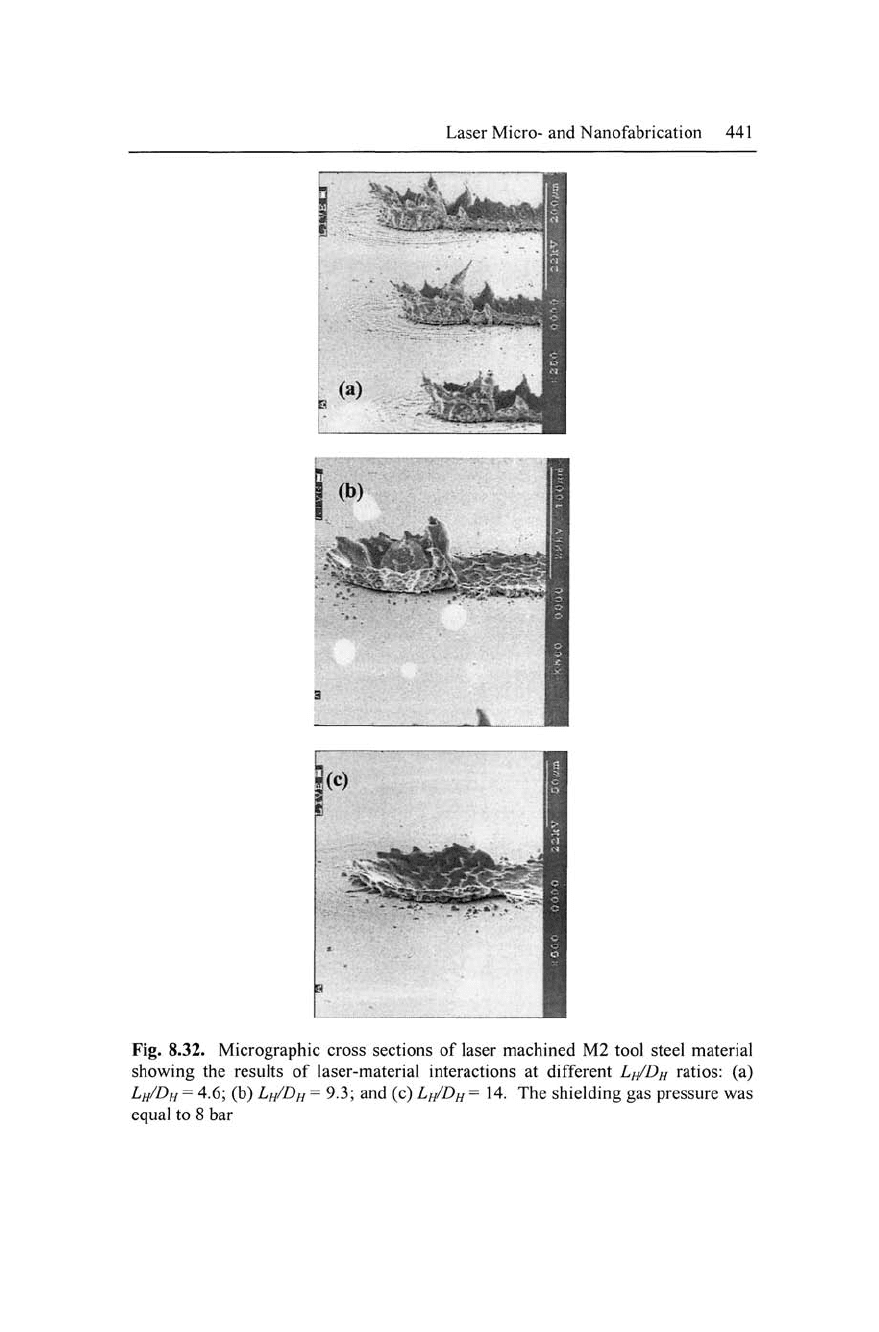
Laser Micro- and Nanofabrication
441
Fig. 8.32. Micrographic cross sections
of
laser machined
M2
tool steel material
showing
the
results
of
laser-material interactions
at
different
LH/DH
ratios:
(a)
LH/DH
=4.6;
(b)
LH/DH
=9.3;
and (c)
LH/DH =
14. The shielding gas pressure was
equal
to
8 bar
